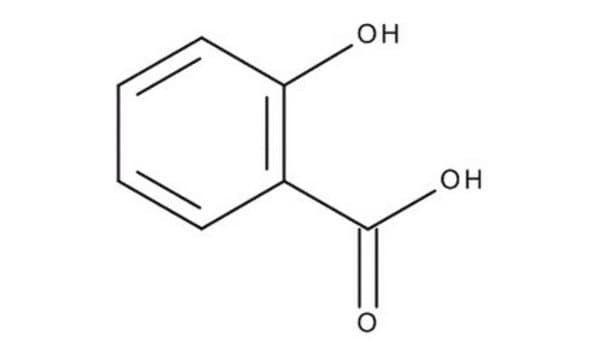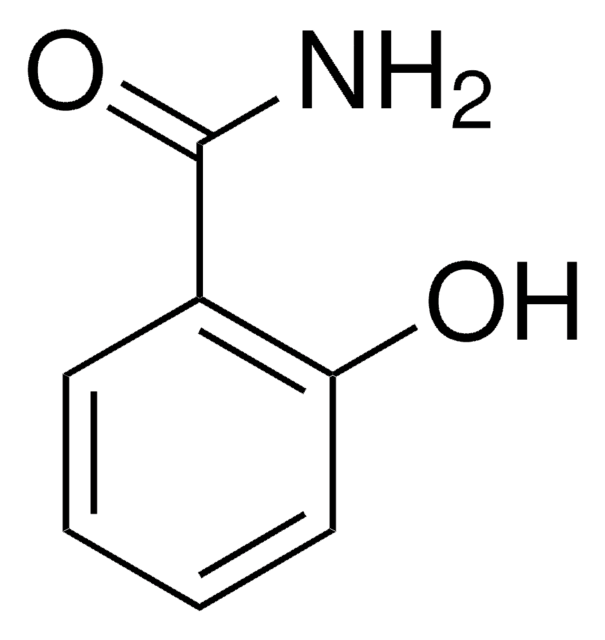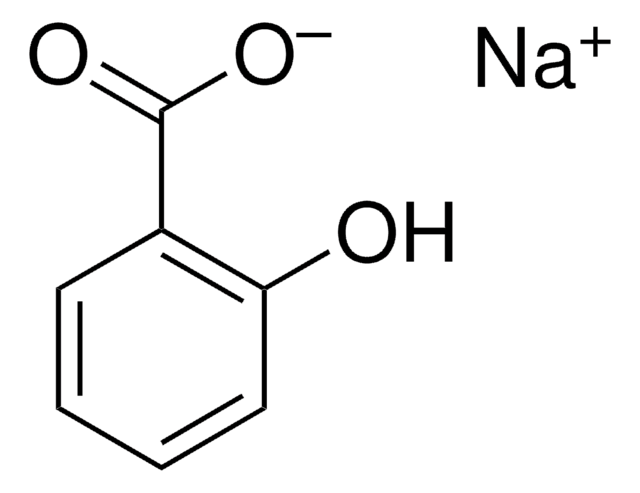Kluczowe dokumenty
1609002
USP
Salicylic acid
United States Pharmacopeia (USP) Reference Standard
Synonim(y):
2-Hydroxybenzoic acid
About This Item
Polecane produkty
klasa czystości
pharmaceutical primary standard
gęstość pary
4.8 (vs air)
ciśnienie pary
1 mmHg ( 114 °C)
rodzina API
salicylic acid
producent / nazwa handlowa
USP
bp
211 °C (lit.)
mp
158-161 °C (lit.)
rozpuszczalność
alcohol: freely soluble
benzene: slightly soluble
boiling water: soluble
chloroform: sparingly soluble
ether: freely soluble
toluene: slightly soluble
water: slightly soluble
gęstość
1.44 g/cm3 at 20 °C
Zastosowanie
pharmaceutical (small molecule)
Format
neat
ciąg SMILES
OC(=O)c1ccccc1O
InChI
1S/C7H6O3/c8-6-4-2-1-3-5(6)7(9)10/h1-4,8H,(H,9,10)
Klucz InChI
YGSDEFSMJLZEOE-UHFFFAOYSA-N
Szukasz podobnych produktów? Odwiedź Przewodnik dotyczący porównywania produktów
Opis ogólny
Zastosowanie
Also used to prepare standard solutions for the assay, impurity analysis, and performance test by using liquid chromatography in conjunction with a UV detector according to the given below monographs of United States Pharmacopeia (USP) :
- Salicylic Acid
- Methyl Salicylate
- Magnesium Salicylate Tablets
- Aspirin Boluses
Komentarz do analizy
Inne uwagi
produkt powiązany
Hasło ostrzegawcze
Danger
Zwroty wskazujące rodzaj zagrożenia
Zwroty wskazujące środki ostrożności
Klasyfikacja zagrożeń
Acute Tox. 4 Oral - Eye Dam. 1 - Repr. 2
Kod klasy składowania
13 - Non Combustible Solids
Klasa zagrożenia wodnego (WGK)
WGK 1
Temperatura zapłonu (°F)
314.6 °F - closed cup
Temperatura zapłonu (°C)
157 °C - closed cup
Wybierz jedną z najnowszych wersji:
Certyfikaty analizy (CoA)
Przepraszamy, ale COA dla tego produktu nie jest aktualnie dostępny online.
Proszę o kontakt, jeśli potrzebna jest pomoc Obsługa Klienta
Masz już ten produkt?
Dokumenty związane z niedawno zakupionymi produktami zostały zamieszczone w Bibliotece dokumentów.
Klienci oglądali również te produkty
Protokoły
Separation of Acetylsalicylic acid, analytical standard; Salicylic acid, BioXtra, ≥99.0%
Separation of Salicylic acid, meets analytical specification of Ph. Eur., BP, USP, 99.5-100.5% (calc. to the dried substance); Acetylsalicylic acid, purum, ≥99.0% (HPLC)
Separation of 4-Hydroxybenzoic acid; Acetylsalicylic acid; Benzoic acid; Salicylic acid; Ethyl 4-hydroxybenzoate
HPLC Analysis of Benzoic Acid Derivatives on Ascentis® C18
Nasz zespół naukowców ma doświadczenie we wszystkich obszarach badań, w tym w naukach przyrodniczych, materiałoznawstwie, syntezie chemicznej, chromatografii, analityce i wielu innych dziedzinach.
Skontaktuj się z zespołem ds. pomocy technicznej










